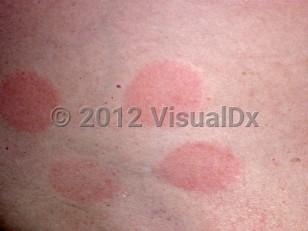Allergic contact dermatitis - Cellulitis DDx
See also in: Overview,External and Internal Eye,Anogenital,Hair and Scalp,Nail and Distal Digit,Oral Mucosal LesionAlerts and Notices
Important News & Links
Synopsis

Contact dermatitis presents as either allergic or irritant in etiology. While irritant contact dermatitis represents the direct toxic effect of an offending agent on the skin, allergic contact dermatitis (ACD) represents a delayed-type (type IV) hypersensitivity reaction that occurs when allergens activate antigen-specific T cells in a sensitized individual. Consequently, whereas irritant contact dermatitis can occur after one exposure to the offending agent, ACD typically requires repeat exposures before an allergic response is noted. ACD can occur 24-48 hours after exposure to the offending agent.
Contact dermatitis can demonstrate well-demarcated borders, suggestive of an "outside job" or external contact. The most common contact allergens are urishiol (poison ivy, oak, or sumac), nickel, fragrance, cobalt (a metal; see also cobalt toxicity), chromates (leather products), neomycin, thimerosal (ophthalmic preparations and vaccines), adhesives, and oxybenzone (sunscreens). The distribution and geometry of lesions are important clues to diagnosis. It can also present as a systemic contact reaction with widespread lesions when the offending agent is ingested or present in an implanted device. ACD can occur in reaction to topical agents, ingested agents, implanted biomedical devices, and airborne materials.
The intense erythema and sharply demarcated plaques of contact dermatitis are easy to confuse with cellulitis or erysipelas, especially when vesiculation and bullae formation take place. Differentiating features include the presence of pruritus (often extreme) in contact dermatitis versus the skin warmth and spreading erythema of a soft tissue infection. A detailed allergen exposure history should be elicited.
Codes
L23.9 – Allergic contact dermatitis, unspecified cause
SNOMEDCT:
40275004 – Contact dermatitis
Look For
Subscription Required
Diagnostic Pearls
Subscription Required
Differential Diagnosis & Pitfalls

Subscription Required
Best Tests
Subscription Required
Management Pearls
Subscription Required
Therapy
Subscription Required
Drug Reaction Data
Subscription Required
References
Subscription Required
Last Updated:10/05/2021
 Patient Information for Allergic contact dermatitis - Cellulitis DDx
Patient Information for Allergic contact dermatitis - Cellulitis DDx- Improve treatment compliance
- Reduce after-hours questions
- Increase patient engagement and satisfaction
- Written in clear, easy-to-understand language. No confusing jargon.
- Available in English and Spanish
- Print out or email directly to your patient



